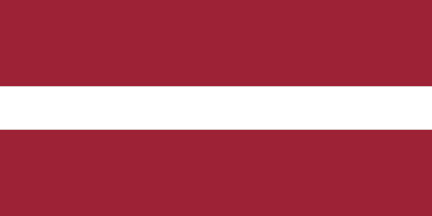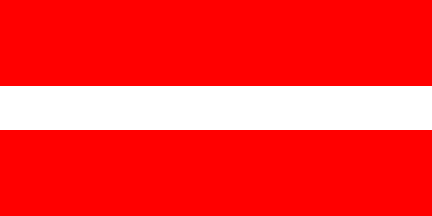 zachary harden
zachary harden
Keywords: latvia | historical | demonstration |
Links: FOTW homepage | search | disclaimer and copyright | write us | mirrors

Last modified: 2023-06-03 by  zachary harden
zachary harden
Keywords: latvia | historical | demonstration |
Links: FOTW homepage |
search |
disclaimer and copyright |
write us |
mirrors
 (1:2)
(1:2)
image by Željko Heimer, 8 April 2002
See also:
The Latvian flag is reputed to date from 1279, which would
make it one of the oldest national flags.
Stuart Notholt, 5 October 1995
The earliest extant reference to the Latvian flag is in a
volume called the Livlandische Reimchronik which dates
from the 14th century. It describes a banner 'red in colour, cut
through with a white strip' used by a Latvian military unit in
1279. The reference was unearthed by a scholar, Janis Grinsbergs,
in the 19th century and was popularized as an ethnic flag for the
Latvian people by students at the University of Tartu in 1870.
The current colours and proportions were adopted on 18 November
1918 when Latvia became independent, having previously been
established in this form in May 1917. It was recognized by law on
20 January 1923.
When the Communists annexed Latvia in June 1940 the flag became
illegal within Latvia itself. However, the west never recognized
the Soviet annexation of the Baltic states and Latvian legations
continued to operate in western capitals. These continued to use
the Latvian flag, as did Latvian emigrés worldwide. The Latvian
flag began to be used again in Latvia in 1988, and was legalized
on 29 September 1988, replacing the Soviet Latvian flag on 27
February 1990. Latvia formally regained its independence on 21
August 1991.
Principal source for the above: "The Flag Bulletin"
XXXI:6/149, Published by the Flag Research Center, Box 580,
Winchester, Mass 01890 USA, November/December 1992, ISSN
0015-3370
Stuart Notholt, 12 December 1995
According to "Flags" by Carol P. Shaw, there are
conflicting stories about the origin of the Latvian flag. It was
first mentioned in a Latvian chronicle of a battle in 1280, where
a battalion from Cesis, a northern region, bore a red flag with a
white stripe which was also the banner of a castle there. Another
legend refers to the leader of a Latvian tribe who was wounded in
battle and wrapped in a white sheet. The part of the sheet on
which he was lying remained white, but the two edges which were
folded over him were stained by his blood.
Bruce Tindall, 13 December 1995
The Constituent Assembly of Latvia declared the official flags
by a law passed 1922-02-15, signed by the President 1923-01-23.
The law also provided for flags and pennants to used by the
President, Prime Minister, other military and civil officials,
warships, fortresses, etc. -- in all a total of seventeen
different flags.
Source: "The Flag Bulletin" VIII:3,
Published by the Flag Research Center, Box 580, Winchester, Mass
01890 USA, Summer 1969, ISSN 0015-3370
Dave Martucci, 7 September 1996
From <www.latnet.lv>:
Many legends about the origin of the Latvian flag come from the
early Middle Ages. One of them, describe events that occurred
before Christianity was established in the Baltics: "A
Latvian castle was surrounded by Estonian troops. The siege
lasted several weeks and the starving residents considered
surrender. The only alternative was to charge over the
battlements to break the enemies lines. Knowing this, an old
kokle (Latvian lute) player, suggested a short prayer and full
scale attack. A ram was sacrificed and the old man took off his
shirt and dipped it in the sacrificial rams blood. The shirt was
completely soaked in blood except where it had been held. The old
man attached this red-white-red coloured material to a shaft.
Waving this as a standard the warriors attacked and drove their
enemy away. Ever since then Latvian fighters have used this
flag."
That is the legend. What about more reliable sources? In the late
1860's one Latvian student (later Dr. Lautenbach-Jusmins) at the
University of Tartu, checked The Rhyme Chronicle of Livonia (the
chronicle of the Order Of Livonia in two volumes written in
rhymes, recording the history of Baltic's from the 1290's and
glorifying the German crusaders) and found at lines 9219 through
to 9223 information on Latvian flag:
"A Brother and a hundred men had come from Wenden to Riga to defend the land, as I have heard. They had been notified. They came in a courtly manner, with a red banner which was crossed by white, in the manner of the Wends. Wenden is the name of a castle from which this flag bacame known, and it is located in the land of the Letts, where women ride in the same fashion as men do. I can tell you this in all truth, this is the banner of the Letts. " from Livlandische Reimchronik by Dr. Ausma Regina Jaunzemils, Stanford University
The current design of Latvian flag was approved in May 1917,
at a meeting of the Art Promotion Association. Several proposals
were reviewed. Finally the design with red-white-red flag having
colour ratio 2:1:2 was accepted. The designer was Ansis Cirulis.
The design was officially adopted as the Latvian flag. During the
Soviet era (Latvia was incorporated in the Soviet Union in 1940)
the use and keeping of this flag was prohibited. The governing
Communist Party considered it the symbol of forces hostile to
Soviet power. Only in the spring of 1990 was the red-white-red
flag restored as the official Latvian flag.
Santiago Dotor, 30 October 1998
From <www.latinst.lv>:
Written records of the red-white-red Latvian flag have existed
since the second half of the 13th century. Bearing a red flag
with a white stripe ancient Latvian tribes went to war against
ancient Estonian tribes. This would place the Latvian flag among
the oldest flags of the world. At the end of the 1860's Latvian
student, folklore researcher and later, professor Jekabs
Lautenbahs–Jusmins found reference to the use of a
red-white-red flag in The Oldest Rhyming Verse Chronicle of the
Livonian Order (in Latvian: Vecaka Atskanu hronika). The
Chronicle depicted events in Latvia in the second half of
13th century (till 1290) and glorified the feats of the crusaders
in converting the pagan inhabitants of the Latvian region to the
Christian faith. Based on the aforementioned historical record,
the present day flag design was adapted by artist Ansis Cirulis
in May of 1917. The red colour of the Latvian flag is a
particular dark red tone that is referred to as “Latvian
red” in the rest of the world. The flags colour proportions
are 2:1:2, but the correlation of the width and length of the
flag is fixed as 1:2. The Latvian national flag, together with
the national coat of arms was affirmed in this format by a
special parliamentary decree of the Republic of Latvia that was
passed on June 15, 1921.
Jarig Bakker, 13 May 2000
Wends have also some possible influence in Latvian flag
history. According to some historical hypotheses in early 10th
century near todays Ventspils was setlement of western slavs
tribe Wend (name of main river of western Latvia Venta (german
Wendau, Windau) comes from this tribe). They live there untill
12th century (Germen influence in Balticum). Wends have moved
eastwards - 1st to Riga, then in central Vidzeme and founded
settlement Cesis (german Wenden). According to historical
documents Wends troops have red/white flags as all western slavs
(like today).
As refered above (and in other documents too) from chronicles and
legends the flag come from Cesis neighbourhood. Some historians
point of view is that Wends was great part in this "Latvian
military unit" (realy there were Livs (Livonians) and Latgalians). Wends as
separate etnicity were recognized untill 16th century.
Gvido Pētersons, 19 September 2000
Latvian colleagues I met in Budapest for a scientific congress
told me an interesting story about the Latvian flag. They said
that after the prohibition of the Latvian flag by Staline regime,
Latvians became fanatic supporters of the football club Spartak
Moscow, because its colour were red-white-red ("normal"
red) and matches were a good opportunity to expose the prohibited
flag. Authorities understood quite quickly the trick ... and the
Spartak was ordered to change its colours. They also told me that
all the stories on the origin of the Latvian colours were
convenient tales.
The licence plates of Latvian cars have the national flag on
them.
Ivan Sache, 15 October 2000
From <www.welcome.lv>:
The flag of Latvia have existed since the second half of the 13th
century. Bearing a red flag with a white stripe ancient Latvian
tribes went to war against ancient Estonian tribes. This would
place the Latvian flag among the oldest flags of the world. The
distinctive dark red color of the Latvian flag is often referred
to in the rest of the world as “Latvian red”.
Dov Gutterman, 25 January 2002

image by António Martins-Tuválkin, 23 December 2005
In 1989-1991, there were many demonstrations in the Baltics
against Soviet rule where medium red latvian flags were used (we
can say it is medium red because of Russian, Lithuanian and even
Soviet flags flying along). This was caused either by lack of
adequate fabric and/or by ignorance about the details of the
1921-1937 flag. These quickly disappeared, replaced with correct
ones.
António Martins-Tuválkin, 23 December 2005
A Latvian friend of mine, who subscribes to many Latvian journals, says that the way they achieved independence in 1990 was by "nullifying" or canceling all Soviet legislation between 1940 and 1990. It was in this way that they reverted to their own national flag and probably to all 17 of the flags adopted in 1923.
To confirm this, I found the following on the Latvian Government Information WWW pages:
- Declaration of the Supreme Soviet of the Latvian SSR on the Renewal of the Independence of the Republic of Latvia (Adopted: 4 May 1990)
- (excerpt) Being determined to restore de facto the free, democratic, and independent Republic of Latvia, The Supreme Soviet of the Latvian SSR decides:
- Section 2
To declare null and void from the moment of inception the decision of 21 July 1940, by the Parliament of Latvia: "On the Republic of Latvia's Joining the USSR".
- Section 3
To re-establish the authority of the Constitution of the Republic of Latvia, adopted by the Constituent Assembly on 15 February 1922, in the entire territory of Latvia. ...
Dave Martucci, 5 September 1996